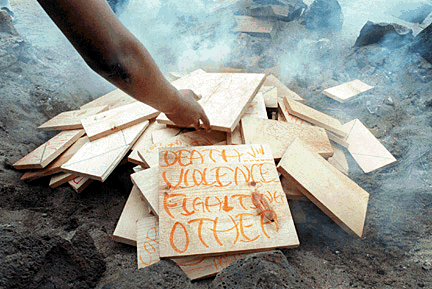Gangs: Troubled youths invade new 'hoods
by Helen Altonn

Signs on which gang members have written their fears are burned at Camp Erdman.
Photo by Ken Ige, Star Bulletin See related story.

Signs on which gang members have written their fears are burned at Camp Erdman.
Photo by Ken Ige, Star Bulletin See related story.
"It's more across the board than it was a few years ago," said Meda Chesney-Lind, criminologist with the University of Hawaii Social Science Research Institute.
Chesney-Lind was principal investigator for the Youth Gang Project study, done for Hawaii's Youth Gang Response System.
The system comprises state, county and private nonprofit agencies that work with kids in schools, law enforcement and prevention programs.
 Police who work with kids and have contact with gang members knew they were starting to spread to different areas, said Sgt. Rodney Goo, head of the gang detail in the Honolulu police Juvenile Crime Prevention Division.
Police who work with kids and have contact with gang members knew they were starting to spread to different areas, said Sgt. Rodney Goo, head of the gang detail in the Honolulu police Juvenile Crime Prevention Division.
He said, however, that they had no figures to back up the trend. "This report substantiates our thoughts."
The survey, coordinated by Marilyn Brown, covered 237 youths in seven response agency programs on Oahu, the Big Island and Maui.
The team also talked to 376 kids in five intermediate schools in different Oahu districts. Except for some eighth-graders at Niu Valley Intermediate School, all were seventh-graders in the Positive Alternative Gang Education program run by Honolulu police with the Department of Education.
More than half the gang education students said they know people in gangs in their neighborhoods, Chesney-Lind noted at a recent Youth Gang Response System meeting.

Investigators were surprised to learn that 42.4 percent of the Niu Valley students surveyed know people in gangs in their neighborhood, she said.
Figures also show a change in Kailua, she noted. "It looked less serious before." Nearly 51 percent of the students questioned said they know gang members in their neighborhood - up from 33 percent in 1992, Chesney-Lind said.
When kids in Kailua were questioned a few years ago, none said they had been, currently were or wanted to be in gangs, she said. Now, 28.8 percent claim friends in gangs and a small percentage say they've been or are in gangs, she said.
Aiea Intermediate School was included because it looked troubled the last time gang research was done there, she said. "The high school had a serious problem with kids getting arrested, and what we see there isn't reassuring."
Of the seventh-graders interviewed in Aiea, 56.9 percent said they know neighborhood people in gangs, and 37.3 percent have friends in gangs.
Goo said a new juvenile gang recently formed in one area and "spread all over town and into the suburbs. One person came from California and organized this group of people so fast I was alarmed."
Different schools were involved, so he believes networking of the kids started at places where they hung out. "The network for kids is incredible," he said.
He said he was concerned because of assaults and crimes related to the gang. "And they were acknowledging they did it. They were trying to make a name for their gang."
Youths told the UH investigators that they joined gangs out of boredom and because of social, economic and emotional reasons.
Agencies in the gang response system are reaching the right kids and having positive results, Chesney-Lind said.
"Outreach workers ... are working with kids very seriously involved with gangs." And prevention programs "are building resiliency into the community," she said.
Overall, Chesney-Lind said, "arrest data don't give us great cause for concern. But we are concerned about the gang problem ... and with cutbacks in youth and social services. The problem isn't going away and resources to do something about it are in jeopardy."